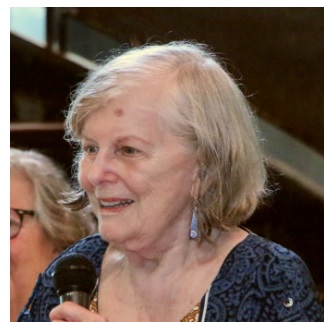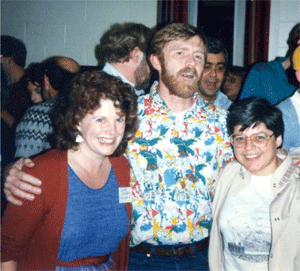Memoir - Connie Rajnak
(formerly Connie G. Chidester, née Gillesby)
Memoir | Publications | Curriculum Vitae | Videos | Slides | Articles | Obituary
ACA Living History
2013

I did not know anything about crystallography until eight years after I graduated from Kalamazoo College. I was working for The Upjohn Company at the time, in a microbiology lab in the "Control" division, and taking classes at Western Michigan University towards a MA in mathematics. I was married and had three children, aged 9, 71/2, and 2. Dave Duchamp, acrystallographer recently graduated from Caltech, needed a research assistant. My name came up in a computer search of Upjohn employees because of my physics background (at K College I majored in physics and philosophy), and because of my mathematics studies at WMU. When Dave explained what crystallography was about I was enchanted; never in my wildest dreamshad I ever thought that I could find a local job that satisfied my love for puzzles and patterns and mental challenges. (This was in 1966, when solving small molecule crystal structures still had afew challenges.) I transferred to the Research Division and learned crystallography, more or lessas an apprentice to Dave. The first ACA meeting I went to was in New Orleans, in 1970, and I was charmed by the welcoming and congenial atmosphere. All one had to do to be invited to join one or another group for dinner was just to stand around after the sessions. The meetingswere small enough that even if you were a stranger, the assumption was that sooner or later you would be an acquaintance. Even well known important scientists, whose work I had only read about, were friendly towards new people. At the 1972 meeting in Albuquerque, I very nervously presented a paper, and found the response forgiving and respectful. Around ′74 or ′75 I was promoted to the scientist track at Upjohn. Except for a sabbatical at the Naval Research Lab in 1985-86, I spent my entire career working for the same company in Kalamazoo.
The people who influenced my scientific development most before Dave Duchamp were my high school math and physics teacher, Carson Neifert, and at Kalamazoo College, professorsAllen Buskirk (physics) and Luike Hemmes (philosophy). From a very early age I had a desireto understand how the world is structured. When it became fashionable in the pharmaceuticalindustry to conduct team-building exercises and formulate mission statements and study motives, I was mildly surprised to find out that some of the other scientists gave as their primary motivation that they wanted to find a cure for some disease, for example, or that they desired recognition — for me the first thing always was simply curiosity.
In the early years, my time at work was spent solving small molecule structures and writing computer programs to run diffractometers, analyze data, etc. We worked closely with the chemists, and because chemists were quite paternal towards their compounds they were supposed to publish first, though we crystallographers were always co-authors. Once in awhile, for exceptional structures, we would get around to publishing a second paper that gave thecomplete crystallographic results, but as there was no pressure to publish, we often neglected to do so. I always presented papers or posters at ACA meetings, but often that research never madeit to a publication. At the 1980 ACA meeting in Calgary, I presented a talk on a new and exciting anti-cancer lead. Because the company had received a government grant for the research, they had to allow publication. Jenny Glusker heard the talk and encouraged me to publish the work, and this gave me the push I needed. The Structure of CC-1065, a Potent Antitumor Agent, and Its Binding to DNA, C. G. Chidester, W.C. Krueger, S.A. Mizsak, D.J. Duchamp, and D.G. Martin, (1981) JACS,103, 7629-35 is appended.
At the 1986 McMaster ACA meeting I presented a talk in the Women's Symposium organized and chaired by Suzanne Fortier to honor her teacher and mentor at McGill U, Gabrielle Donnay.A photo of many of the women who attended the symposium, together with the speakers isbelow. My talk, with cartoons supplied by my daughter Stacey, is appended.
Speakers and attendees at the Women's Symposium, McMaster University, 1986.In front, Judy Flippen-Anderson; first row, left to right: Helen Berman, Connie Chidester, Norma Duke, Gabrielle Donnay, Suzanne Fortier, Carol Brock, Jane Griffin, Kay Onan; Second row: Jenny Glusker, Ann Glusker, unknown, Martha Teeter, Cheryl Klein, unknown, Miriam Rossi, unknown, Penny Codding, Virginia Pett, Kim Watson, Marie Fraser, unknown.

Connie with Bill Duax and Vivian Cody at the 1986 McMaster meeting.
Connie's daughter Stacey Chidester, who drew the cartoons for Connie's talk (1986).
During the 1980s, there were tremendous advances in structure-solving computer programs, especially in direct methods. The number of small molecule structures that were difficult to solvegradually diminished until in the latter part of the decade the challenges had less to do with solving the structure and more and more to do with understanding function in terms of structure — whatmade drug molecules bind to receptors and what was their mode of action. Structure based drug design became my primary interest, and I focused on central nervous system drugs. Benzodiazepines were in this category, but ultimately I focused on compounds that bound to thedopamine and serotonin receptors. For several years in the 1990s, I felt as though I was in crystallography heaven because at Upjohn researchers had developed a marvelous database that kept track of all biological tests — including binding at the various receptors — on every compound synthesized at Upjohn as well as other drugs on the market. Making my research even moreinteresting, these tests categorized compounds as agonists or partial agonists or antagonists. Therewere also many subcategories of receptors: dopamine D2, D4, and so on; 5-HT1a, 5-HT2c, etc. (serotonin is 5-hydroxytryptamine). In 1992 I attended a Gordon Conference on medicinal chemistry and presented work that was subsequently published: Comparison of 5-HT1a and Dopamine D2 Pharmacophores. X-ray Structures and Affinities of Conformationally Constrained Ligands, Connie G. Chidester, Chiu-Hong Lin, Robert A. Lahti, Susanne R. Haadsma-Svensson, &Martin W. Smith, (1993) J. Med Chem 36, 1301-15. Drug design at that time was complicated by the fact that the drugs on the market for CNS disorders, at least those which exhibited binding to dopamine and serotonin receptors, were not at all selective for particular receptor subtypes, so itwasn't possible to know which subtypes might affect depression, or anxiety, or psychoses, or insomnia, or hunger.
During this period in my career, the way that research was done at Upjohn changed for the better. The company introduced "project" teams. The idea was to have chemists, cell biologists, biochemists, drug metabolism scientists, computer people, and crystallographers all represented on teams that aimed to find drugs for the various diseases. Scientists on each team reported pertinentresearch to the project team leader and reported administratively to a section head; the sections wereorganized by discipline not disease. I was on the central nervous system disease team, but there were a number of other teams. I thought the CNS team worked extremely well together, butsympathized with colleagues who had less satisfactory teams, as success naturally depended on thepersonalities of the various team leaders and section heads. From 1995 on the company endured anumber of mergers, first with the Swedish company Pharmacia, which had previously merged with Farmitalia of Italy. Our name after this merger was PNU for Pharmacia and Upjohn. Then a fewyears later we merged with Monsanto, and our name changed again — to Pharmacia. Meanwhile very high quality research continued in spite of the considerable distractions.
My personal contribution to research did not go as well. I retired in 2001, very disappointed that I had not been able to achieve my goal of designing, in partnership with a chemist, a compound thatuniquely fit the requirements of any one of several pharmacophores that were known by then. All the chemists, when deciding on a new series of compounds to synthesize, studied the patentsituation first. If something could not be patented, there was no point in working on it. For my part, I did not know chemistry well enough to know if it was even feasible to put, say, a hydroxy group here or or a phenyl group there on a compound already synthesized, much less to change thebasic ring structure. Furthermore, it seemed that our crystallography lab might be inundated with structure requests not related to my main interest from non-Kalamazoo chemists. In 2001 I decided to retire, and hoped that retirement would not isolate me altogether from science and from my colleagues in crystallography. I was just coming off the ACA council and planned to ask if I could replace Ron Stenkamp as Co-Editor of the ACA Newsletter when he no longer wanted the job (Ron had replaced me when I gave up the job in ′93). In 2002 Pharmacia was bought by Pfizer, and in 2003 the research division was disbanded — no more research in Kalamazoo. Even the building that I worked in is gone.
My Past President's Address at the 2001 ACA meeting in Los Angeles, again with cartoons kindly provided by my daughter Stacey, is appended, as are 2012 photos of Stacey and Stacey with me.
The Council did indeed approve me for the Co-Editor job, and Ron did indeed bow out after the fall 2002 issue. In 1991 I had adapted the newsletter to a desk-top publishing program version from theadmirable ACA Newsletter edited for many years by Jenny Glusker. Since then the desk-top publishing program has evolved from Adobe Pagemaker to and through several versions of Adobe InDesign, and the ACA Newsletter in black and white has become the RefleXions news magazine. Recently Judy Flippen-Anderson and I have attempted to make our Co-Editor jobs easier by adding other volunteers to the RefleXions staff. We now have a Staff Photographer who will probably also do the annual meeting promo pages; a Books Editor; a Puzzle Corner Editor; a Historian; an Art in Crystallography Editor and a Copy Editor, and we are recruiting for News & Awards and Opinions Column editors.
More...
|